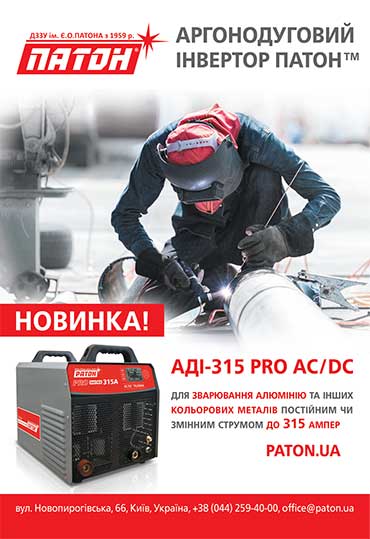| 2020 №11 (02) |
DOI of Article 10.37434/as2020.11.03 |
2020 №11 (04) |

"Avtomatychne Zvaryuvannya" (Automatic Welding), #11, 2020, pp. 14-19
The quality and operational characteristics of welded joints of pipes from different types of polyethylene
M.O. Kovalchuk, M.V. Iurzhenko, V.L. Demchenko, M.G. Korab, R.V. Kolisnyk
E.O. Paton Electric Welding Institute of the NAS of Ukraine. 11 Kazymyr Malevych Str., 03150, Kyiv, Ukraine. E-mail: office@paton.kiev.ua
At the beginning of construction of plastic pipelines, so-called «low pressure polyethylene», now known as PE‑63 was used. Subsequently, new, more advanced types of raw materials, which are a copolymer of polyethylene with hexane, were developed. Today, almost all pressure pipes are made from PE‑80 and PE‑100 types of polyethylenes. However, during the repair and reconstruction of plastic pipelines, there is an urgent problem of joining pipes from PE‑63, which have been used for a long time, with new pipes made of polyethylenes of PE‑80 and PE‑100 types. In this work, complex researches of thermophysical properties of technical polyethylenes were carried out and significant differences were revealed which must be taken into account when repairing polymer pipelines. Experimental welding of pipe samples from both the same and different types of polyethylenes was carried out. Morphological and mechanical studies of welded joints of polyethylene pipes of PE‑63, PE‑80, and PE‑100 types, were performed. According to the research results, the influence of their thermophysical properties and parameters of the welding process on the morphological structure and quality of welded joints of different types of polyethylenes was determined. Mathematical modeling of temperature fields during butt welding was carried out. A two-zone heating tool was developed and created for heated tool butt welding of pipes with an outer diameter of up to 110 mm from different pipe polyethylenes of PE‑63 and PE‑80, PE‑100 types. In order to test a prototype of a two-zone heating tool, a series of experiments were carried out, which showed an improvement in the strength characteristics of the obtained welded joints. 8 Ref., 4 Tabl., 10 Fig.
Keywords: polyethylene raw materials of different types, polyethylene pipes, welded joints
Received: 13.10.2020
References
1. Kimelblat, V.I., Volkov, I.V., Glukhov, V.V. (2020) Optimization of resistance butt welding. Accounting for the properties of polymers. Polimernye Truby, 2, 28, 32–36 [in Russian].2. Komarov, G.V. (2015) Composition and properties of polymer materials affecting their weldability. Polimernye Materialy, 9, 44-48 [in Russian].
3. GOST 16338-85: Low-pressure polyethylene. Specifications [in Russian].
4. GOST R 50838–95: Polyethylene pipes for gas pipelines. Specifications [in Russian].
5. DSTU B V. 2.7-73-98: Polyethylene pipes for the supply of gaseous fuel. Specifications [in Ukrainian].
6. DSTU B V.2.7-151:2008: Polyethylene pipes for the supply of cold water. Specifications [in Ukrainian].
7. DBN V. 2.5–41:2009: Gas pipelines from polyethylene pipes. Design. Construction [in Ukrainian].
8. DSTU EN12814–2:2018: Testing of welded joints of thermoplastics semi-finished products. Pt 2: Tensile test [in Ukrainian].
Advertising in this issue:
The cost of subscription/purchase order journals or individual articles
| Journal/Currency | Annual Set | 1 issue printed |
1 issue |
one article |
| TPWJ/USD | 384 $ | 32 $ | 26 $ | 13 $ |
| TPWJ/EUR | 348 € | 29 € | 24 € | 12 € |
| TPWJ/UAH | 7200 UAH | 600 UAH | 600 UAH | 280 UAH |
| AS/UAH | 1800 UAH | 300 UAH | 300 UAH | 150 UAH |
| AS/USD | 192 $ | 32 $ | 26 $ | 13 $ |
| AS/EUR | 180 € | 30 € | 25 € | 12 € |
| SEM/UAH | 1200 UAH | 300 UAH | 300 UAH | 150 UAH |
| SEM/USD | 128 $ | 32 $ | 26 $ | 13 $ |
| SEM/EUR | 120 € | 30 € | 25 € | 12 € |
| TDNK/UAH | 1200 UAH | 300 UAH | 300 UAH | 150 UAH |
| TDNK/USD | 128 $ | 32 $ | 26 $ | 13 $ |
| TDNK/EUR | 120 € | 30 € | 25 € | 15 € |
AS = «Automatic Welding» - 6 issues per year;
TPWJ = «PATON WELDING JOURNAL» - 12 issues per year;
SEM = «Electrometallurgy Today» - 4 issues per year;
TDNK = «Technical Diagnostics and Non-Destructive Testing» - 4 issues per year.









